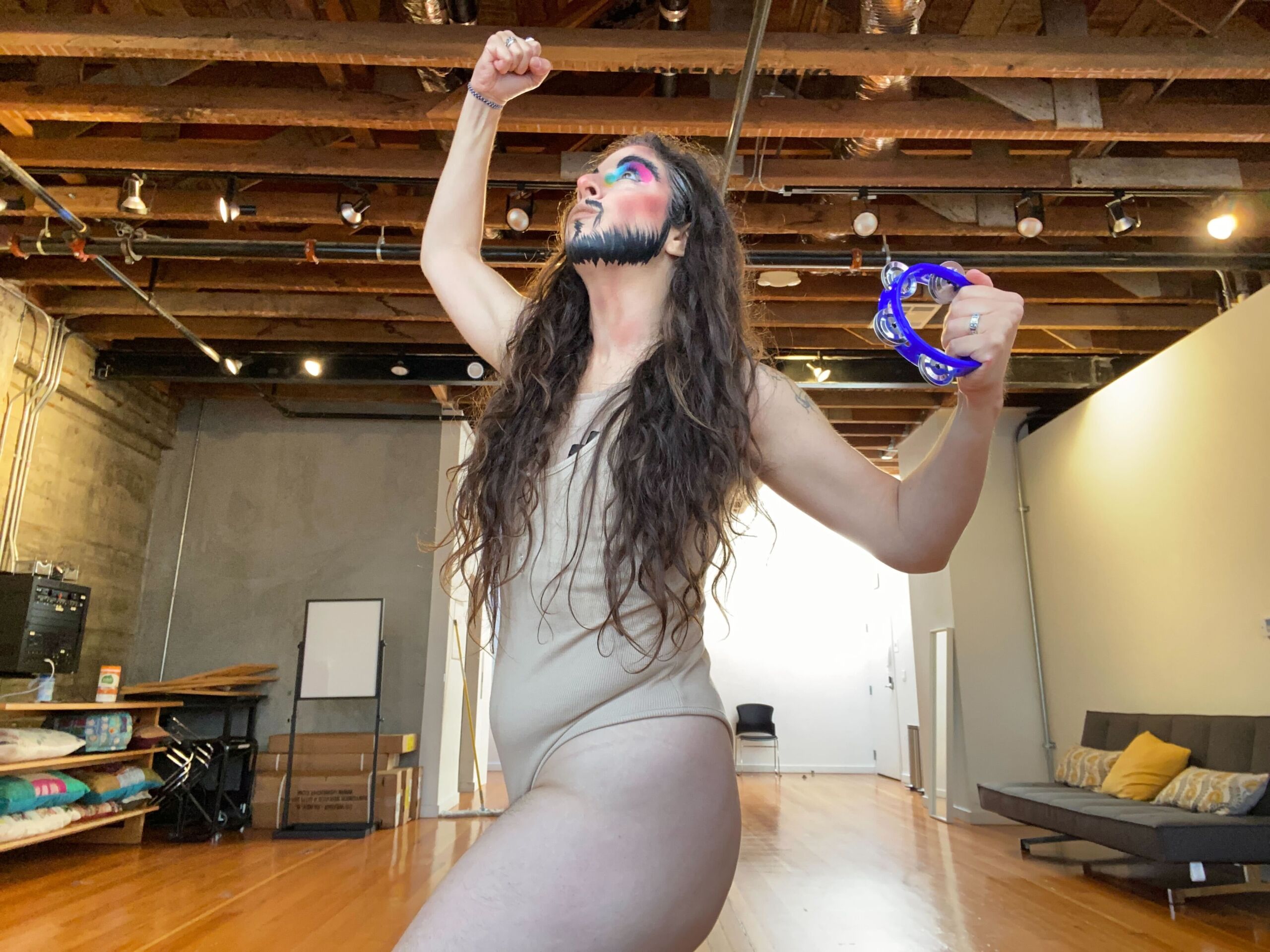What is kathak?
Kathak is a unique dance form which incorporates rhythmic virtuosity, compelling storytelling, poetry, recitation, song, swift and subtle movement, and a rich philosophy whose roots extend thousands of years. In 1992, I enrolled in a Kathak class at SFSU with world-renowned master, Pandit Chitresh Das. Little did I know the vast ocean that lay before me. Enthralled by the immense depth and potential for self-expression, I continued to study in the traditional manner (guru shisya parampara), one on one, as well as in the class, the rehearsal setting, and while accompanying Pandit Das around the world.
Kathak is traditionally learned through the guru- shisya parampara. There are no short cuts. It takes decades of reyaz (disciplined practice and refinement) and sadhana (practice which is a spiritual practice). Kathak is traditionally performed solo. There are four basic elements:
- tayari, the technical readiness with the movement vocabulary of the dance
- laykari, rhythmic virtuosity
- khubsurti, beauty
- nazakut, delicacy, or refinement, in the dance.
Given that the emotional nuances of kathak are very important, (after-all, kathak comes from the word ‘katha’ meaning to tells stories, so the kathaka is the storyteller) the nava rasa or nine emotional sentiments are a boundless source of exploration: love, peace, sorrow/ pathos, disgust, humor, wonder, terror/fear, anger, and heroism. Within each of these are minute nuances, called anubhava, and are myriad in interpretation. With the complex web of anubhava and laykari, a dancer can spend a lifetime exploring, reaching, and refining. To be a kathak artist requires maturity and ongoing exploration. It takes a lifetime to make a Kathak master.
Historically, Kathakas were hereditary wandering bards illuminating epics through dance, mime, poetry, song and music. Kathak, like all Indian Classical Dance, has distinct devotional elements as it once was performed in temples. Kathak is one of the only art forms with both Hindu and Muslim roots. In the middle ages,

Pandit Chitresh Das as a teenager wearing traditional Hindu costume for men

Chitresh Das, age 10, wearing traditional Muslim costume
moghul rulers brought Kathak into the courts where it slowly became a classical art form with its refined subtlety of manner and intricate rhythmic flourishes. The twentieth century moved the form into a proscenium art, pushing the speed, virtuosity, and dramatic dance dramas to new heights and adding to the movement vocabulary.

Chitresh Das with Uday Shankar, regarded as the "father" of Creative/Contemporary dance in India
Kathak is not a stagnant form passed down from generation to generation, but a constantly evolving tradition. Great masters, such as Pandit Das, have created innovations within tradition which are elevating the form to new levels of virtuosity, complexity, and compelling relevance in the world at large.

Chitresh Das with Rukmini Devi, regarded as the "mother" of modern Bharatnatyam and Manipuri dancers
While Pandit Das continues to evolve and push the boundaries of the art-form, he at the same time insists on holding serious students who seek to be soloists to the highest standard in Kathak, being able to improvise, sing, recite, perform with highly accomplished tabla players without rehearsal and attain knowledge of the deep history, philosophy and mathematics involved in the highly complex rhythmic system of Classical Indian music. I am such a student. As as a senior disciple of Pandit Das, I am deeply committed to the process that is the kathak solo which can take 2-3 hours to unfold. I am not only committed to it, I find it very exciting and rejuvenating. Everytime you perform a solo, you have the opportunity to reinvent yourself.
What relevance does kathak hold in our urban multicultural landscape?
Some aspects of the art are and always have been relevant and universal, such as dancing for joy and tapping into the divine energy, finding connection to spiritual awakenings and transformations for the dancer. Kathak holds relevance in the modern world simply because it is a unique expression of the individual mining the depths of a powerful tradition with universal truths. The kathak solo is an exploration of life through dialogue on stage and in the moment. This is where traditional becomes contemporary, in the now– And Classical becomes modern. There is no dichotomy, no boundaries.
In 2006, I performed a shortened version of the Kathak solo) at Yerba Buena Center for the Arts during Kathak at the Crossroads Festival and Symposium along with many other of the world’s most eminent kathak artists. Diving into the tradition of upaj, improvisation, brought the immediacy and contemporary nature of kathak into full view for me in contrast to some artists who performed fixed or choreographed items.
A Kathak solo traditionally starts with a Vandana, focusing inward with a mediative verse invoking the divine force, then warms up with Thaat, orienting toward the audience, pulling them into the internal dialogue, then delves deep into a conversation with the musicians. The triangle of audience, dancer, and musicians participate in cycles of creation and dissolution building to a climax. Then the stories are told, relating universal truths, morals, human conditions and sentiments of age-old concerns. One of the oldest classic stories is Govardhan Giri, where Krishna lifts the mountain to shelter the people from the rising flood waters unleashed by the arrogant fury of Indra. This ancient story holds contemporary lessons about global warming, unsustainable lifestyles, and industrial pollution.

Charlotte Moraga performing nritya aspect of kathak in Santa Clara in a festival showcasing four other Indian Classical Forms, presented by Yuva Bharati. Also shown, Salar Nadar, Ben Kunin, Rachna Nivas and Antara Bhardwaj
The challenge for this new work for Performing Diaspora is to take the Kathak solo and boil it down to 30 minutes that is full and succinct. The rhythmic structure of definite beats, called taal, is an unending cycle that begins on one and ends on one. The first beat is called Sum, and also the last beat in the cycle. You begin and end the cycle on sum, creating and dissolving your dance. The idea is for the dancer and musicians to end together harmoniously on sum. Here destruction is seen as a creative act in itself as it makes way for rejuvenation. This construct is replicated on so many levels in so many different ways. There are the three gurus, or Hindu trinity, Brahma, the creator, Vishnu, the preserver, and Maheswara, the destroyer. During the Performing Diaspora residency, I will be experimenting with distilling the kathak solo into a triptych type format mirroring this theme in collaboration with virtuosic musicians.
What is the responsibility of the diaspora?
In 2007 I performed a kathak solo in Mumbai in front of a large and learned audience and was honored to receive a standing ovation from different generations of artists, dancers and gurus. Right before that concert, I took this photo. Since then, the image sticks with me.
Here is this palm tree being consumed by another kind of tree in a sea of cars in the parking lot of the Mumbai apartment complex. I was struck by the metaphor– A metaphor for life in Mumbai, or my own urban life style in San Francisco? Yes, but also, a metaphor for classical Indian dance like kathak.
Perhaps the tree is as a warning: One must be careful when experimenting with innovation in a traditional form, so that the original form is not diluted, confused or consumed. But, if one is deeply trained, it is not necessary to worry about such things. The palm (quite possibly the Borassus flabellifer, commonly known as the palmyra, although it’s hard to tell as it is so mangled) could be kathak, being consumed by the strangler fig, representing influences of western pop culture, Hollywood, Bollywood, fusion, etc… in a parking lot filled with cars, other dance and performance styles. In the parking lot of entertainment miasma, neither gets the nourishment it needs to flourish. Or the fig tree could be me, the foreigner consuming the native species. But, who is the foreigner? After all, the palmyra is actually originally from Africa making the strangler just as native as the palmyra, or foreign, depending on your point of view.
Regardless of what metaphor you like, the diaspora is in flux. One no longer need go to India to study Classical Indian Dance arts authentically. Ustad Ali Akbar Khan, widely recognized as the foremost master of sarode in Indian Classical Music made his home in Marin, and brought with him other artists that are recognized in India and around the world as the very best in their fields, such as Ustad Zakir Hussain, Pandit Swapan Chaudhuri, and Pandit Chitresh Das (In fact, Pandit Das is being recognized this year by the NEA with the National Heritage Award in September — congratulations Guruji!).
Also, the Classical Indian dance diaspora is no longer just Indians bringing their art forms from India to teach in foreign countries. What about me, as a white woman, originally trained in ballet and jazz dance, but now strictly kathak, going back to India to teach Kathak to students there? It’s not just about race and nationalism, but an ideology, and a continuum of heritage from gharana to gharana (school of thought), not necessarily based in nationality, but certainly community. It is passed down from teacher to student. Teacher is defined as Guru in the Indian Classical system and student as devotee. What does that mean?
My guru has an old saying, “Freedom comes from refined discipline with responsibility.” First you must learn properly, then if you are seriously practicing and innovating in a traditional form, you have a responsibility to the generations before you, and after you, to the cultural heritage and legacy. You need to honor the continuum. You need to make knowledgeable choices.
What is it about kathak that needs to be preserved, nurtured, recognized and developed? For me, the concept of upaj, improvisation, seems to be at the heart. The freedom to respond spontaneously with the use of subtle nuances or not so subtle nuances of expression and different types of footwork and movement, rhythms, permutations and combinations that can be developed through the dialogue of exchange with live music is at the heart of kathak.
This doesn’t mean that an artist can’t delve into choreography. It has its place too. I personally enjoy choreographing new pieces. I also enjoy performing choreographed dances. There is a certain comfort in it, like a fuzzy blanket wrapped snug around you. It’s a wonderful tool for staging dance dramas and for burgeoning dancers to learn how to move and command a stage. However, in the solo, it must not take precedence. It can be used as a structure that allows for spontaneity and free exchange to blossom.
Upaj can be daunting. And you can loose your way, but the sheer joy and challenge of finding your way back can find no parallel, and the audience can feel it. It’s palpable, that edge-of-your-seat thrill and what-will-come-next energy that is at the heart of kathak, upaj. Upaj can be raw, leading some gurus to abandon it as dancers may not look polished and pristine. But why? That always has been a part of kathak. It may not always look polished, neat and refined. It may look raw, yet it is refined. It’s a refined sensitivity to the flow of divine energy. I am deeply inspired by the great masters that are taking risks by improvising compositions and such in concert and strive to do that in my own performances. In the tradition, it is acceptable to do it again if you don’t end on sum together, and hopefully, next time, you’ll get it right.
Share This!
More Good Stuff
Unsettled/Soiled Group is a group of East, Southeast, and South Asian diasporic movers, makers, and settlers on Ramaytush and Chochenyo Ohlone land. Unsettled/Soiled Group is led by June Yuen Ting, one of CounterPulse's 2022 ARC Performing Diaspora artists and will debut Dwelling for Unsettling alongside VERA!'s Try, Hye!, Thursday through Saturday, December 8-10 & 15-17, 2022
Try, Hye! by Vera Hannush/VERA! & Dwelling for Unsettling by Unsettled/Soiled Group December 8-10 & 15-17, 2022 // 8PM PT // 80 Turk St, SF
VERA! (they/them) is a queer Armenian American drag king, dancer, and community activist. They are one of CounterPulse's 2022 ARC Performing Diaspora artists and will debut Try, Hye! alongside Unsettled/Soiled Group's Dwelling for Unsettling, Thursday through Saturday, December 8-10 & 15-17, 2022





Thank you Charlotte for being a fearless advocate and representative of this deep and ancient tradition that is so relevant in modern times. Your reflective process and commitment to deep integrity and artistry is very heartening!
hi charlotte,
i’m excited to see you perform tonight – i’ve heard such good things about your work. i’m working on a thesis that examines overlaps between dance/choreography and architecture. would love to work with you on some analytical videos at the counterpulse studio and also to discuss Kathak (or rather hear you speak!).
best,
dev
Namaskar Dev,
It would be interesting to explore the relationship between architecture and karanths in kathak. hope you enjoyed the performance.
oh i never checked back! i thought i had left you my email address! it’s devdutt@mac.com
i have booked the counterpulse studio from 12 to 6pm on the 17th and the 23rd and am asking dancers/choreographers to come help me with my experiments. if you can email me i will send you more info to your email and my contact number too.
really hope you can come in for an hour or two on those days!